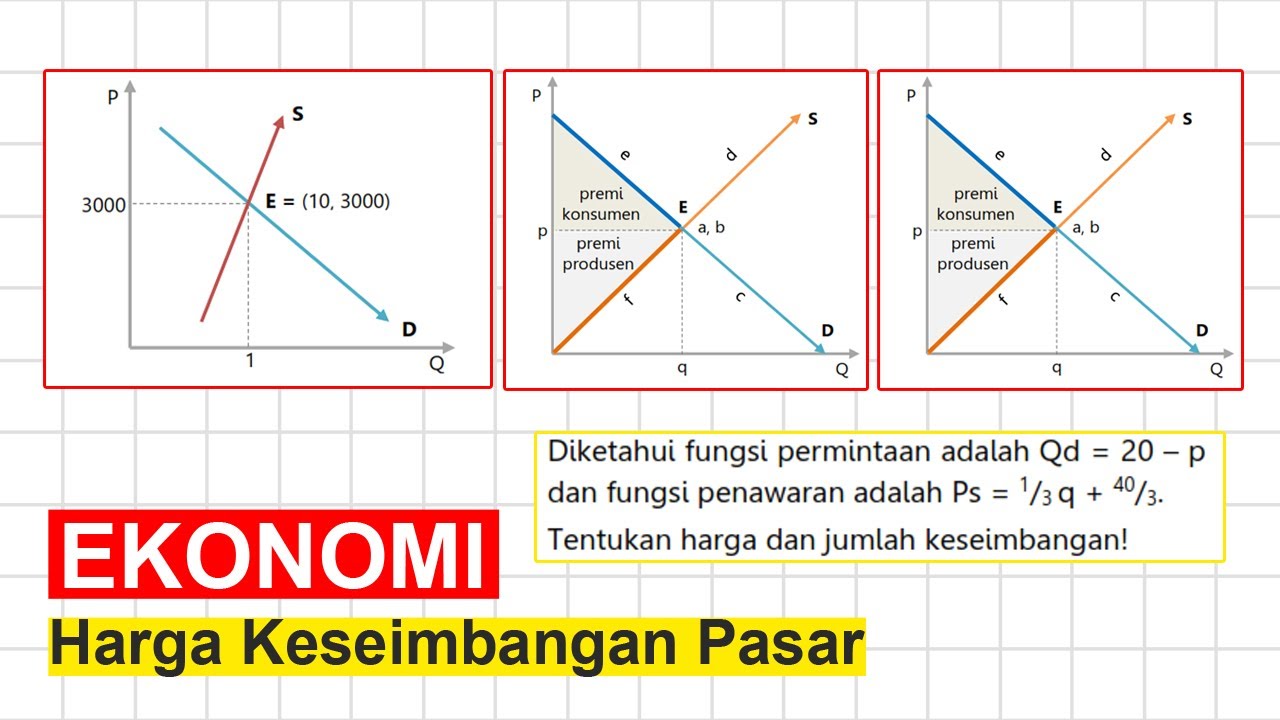Exploring Equilibrium
Summary
TLDRThis video provides a quick review of equilibrium in economics, focusing on the concept of the equilibrium price, where the quantity demanded equals the quantity supplied. It explains how market forces push prices towards equilibrium, whether there's a surplus or a shortage. The video also discusses the equilibrium quantity, emphasizing how it maximizes gains from trade, with no wasteful trades or unexploited gains. The concept of consumer and producer surplus is highlighted, and the importance of a free market in achieving efficient outcomes is reinforced.
Takeaways
- 😀 Equilibrium price is where quantity demanded equals quantity supplied.
- 😀 At prices above the equilibrium price, there is a surplus, pushing the price down.
- 😀 At prices below the equilibrium price, there is a shortage, pushing the price up.
- 😀 The equilibrium price is the only stable price in a free market.
- 😀 The equilibrium quantity occurs where the quantity demanded equals the quantity supplied.
- 😀 If the quantity bought and sold is not at equilibrium, there are unexploited gains from trade.
- 😀 Buyers and sellers will naturally adjust their behavior to reach the equilibrium quantity.
- 😀 If the quantity exceeds equilibrium, waste occurs because the product is not worth the price to buyers.
- 😀 Free markets naturally eliminate waste and maximize the gains from trade.
- 😀 The gains from trade can be divided into consumer surplus and producer surplus.
- 😀 The equilibrium price ensures that goods are bought by those who value them most and sold by those with the lowest costs.
Q & A
What is the equilibrium price?
-The equilibrium price is the price where the quantity demanded equals the quantity supplied. It is the point where there is no surplus or shortage in the market.
What happens if the price is set higher than the equilibrium price?
-If the price is higher than the equilibrium price, there will be a surplus, as the quantity supplied will exceed the quantity demanded. Sellers will have more goods than customers, leading them to lower the price towards equilibrium.
What occurs if the price is set lower than the equilibrium price?
-If the price is lower than the equilibrium price, there will be a shortage. The quantity demanded will exceed the quantity supplied, and buyers will compete for the goods, pushing the price back up towards equilibrium.
Why is the equilibrium price considered stable?
-The equilibrium price is stable because it is the point where the forces of supply and demand are balanced. Any deviation from this price results in forces (surplus or shortage) that push the price back towards equilibrium.
What does the equilibrium quantity represent?
-The equilibrium quantity is the quantity where the quantity demanded equals the quantity supplied. It ensures that all potential gains from trade are fully exploited, as there is no shortage or surplus.
Why does the market adjust to the equilibrium quantity?
-The market adjusts to the equilibrium quantity because any other quantity will result in unexploited gains from trade. Buyers and sellers will find opportunities to improve their welfare by adjusting the quantity of goods traded.
What would happen if the quantity bought and sold is greater than the equilibrium quantity?
-If the quantity is greater than the equilibrium quantity, there would be waste. Suppliers would be selling goods at a loss, as their costs exceed the price buyers are willing to pay, which cannot be sustained in a free market.
What is the role of consumer and producer surpluses in a free market?
-In a free market, consumer and producer surpluses represent the gains from trade. Consumer surplus is the benefit buyers receive when they pay less than they are willing to, while producer surplus is the benefit sellers receive when they sell at a higher price than their cost.
How does the equilibrium price split the demand curve?
-The equilibrium price splits the demand curve such that the goods are bought by buyers who value them the most, while the goods are sold by the sellers with the lowest costs. This maximizes efficiency in the market.
What does the concept of 'no waste' mean in the context of a free market?
-In a free market, 'no waste' means that all trades are efficient. There are no unexploited gains from trade, and all resources are allocated in a way that maximizes value without unnecessary surplus or shortage.
Outlines

Esta sección está disponible solo para usuarios con suscripción. Por favor, mejora tu plan para acceder a esta parte.
Mejorar ahoraMindmap

Esta sección está disponible solo para usuarios con suscripción. Por favor, mejora tu plan para acceder a esta parte.
Mejorar ahoraKeywords

Esta sección está disponible solo para usuarios con suscripción. Por favor, mejora tu plan para acceder a esta parte.
Mejorar ahoraHighlights

Esta sección está disponible solo para usuarios con suscripción. Por favor, mejora tu plan para acceder a esta parte.
Mejorar ahoraTranscripts

Esta sección está disponible solo para usuarios con suscripción. Por favor, mejora tu plan para acceder a esta parte.
Mejorar ahoraVer Más Videos Relacionados

Ekonomi Kelas X - Harga Keseimbangan

Harga Keseimbangan Pasar / Ekuilibrium Pasar - EKONOMI

Permintaan, Penawaran, dan Keseimbangan Pasar - Materi Ekonomi SMA dan Ujian Mandiri

Pengantar Ekonomi Semester 1

Market equilibrium | Supply, demand, and market equilibrium | Microeconomics | Khan Academy

The Equilibrium Price and Quantity
5.0 / 5 (0 votes)
